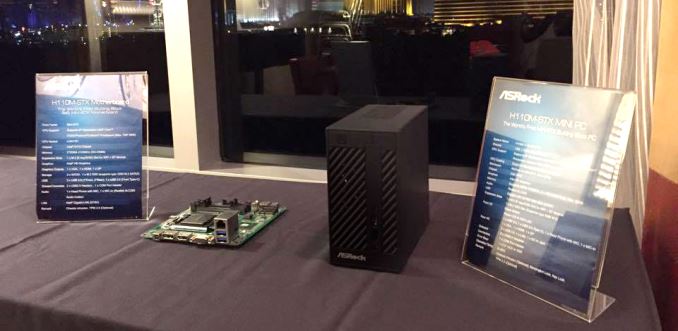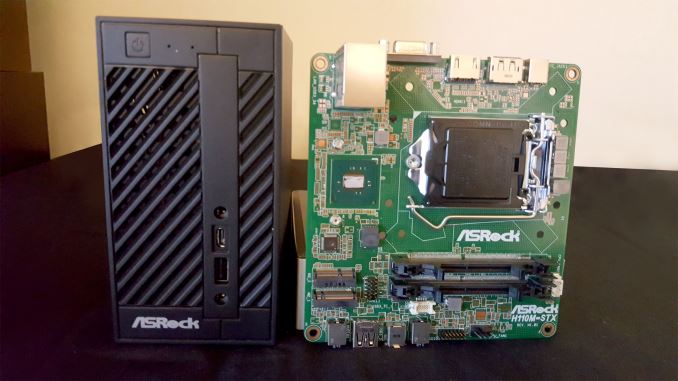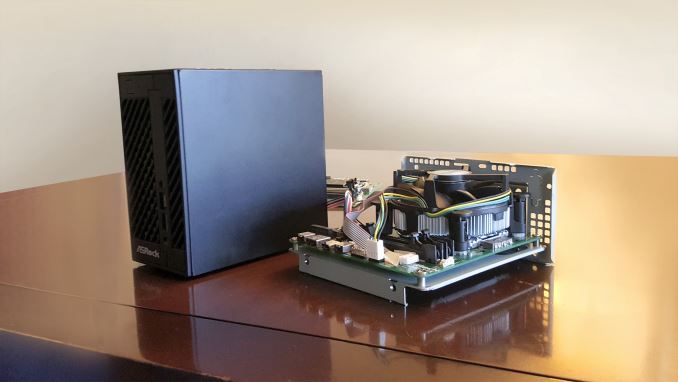CES 2016: ASRock Shows mini-STX 5x5 for Business and Education
by Ian Cutress on January 21, 2016 2:00 PM EST
Ever since Intel announced their 5x5 platform (that’s 5-inch by 5-inch), we have had several requests from users saying ‘when?’. At the time of the announcement, it was difficult where Intel was trying to place the platform – the goal seemed to show something for embedded platforms that also had a socketed processor. This would allow customers to choose how much processing power they needed up to 91W if it is built for it, or potentially upgrade later down the line. This is compared to the NUC, which runs mobile processors in an even smaller form factor. Despite the interest from end-users, it has always come across as a non-consumer play. ASRock’s showcase at CES pushes it further into that B2B market with specific verticals in mind.
We learned that 5x5 now has an ‘official’ name in Mini-STX, similar to mini-ITX which is 6.7-inch square. But on display from ASRock were a singular motherboard, the H110M-STX, and a prebuilt system called the H110M-STX Mini PC.
As the H110 name implies, this system is for Skylake processors and built on the H110 chipset. The motherboard uses a three-phase power delivery, rated at 65W, and memory comes via two DDR4 SO-DIMM slots supporting up to 32GB of DDR4-2133 (we wouldn’t really expect anything higher than 2133 in this form factor anyway). The socket area pushes right up against what would be the rear IO panel because of space, and the ports here have a low z-height to ensure cooler compatibility.
Storage comes via an M.2 2280 slot supporting SATA 6 Gbps – the specifications say it also has two SATA 6 Gbps ports, but unless they’re available through a breakout cable I can’t see the traditional way to connect these to a motherboard. Network connectivity is through the Intel I219-V NIC as well as an M.2 2230 slot for WiFi and BT. Video output is designed to come through the processor (so Intel HD Gen 9) and the rear IO has a VGA, HDMI and DP port for use. There are two USB 3.0 ports on the back as well as one on the front, two USB 2.0 headers, and a custom USB-C header for the H110M-STX Mini-PC. Audio comes via a Realtek ALC283 codec using the onboard header. TPM 2.0 is also included.
As for the Mini-PC system ASRock showed, this is designed specifically for this motherboard only and comes in at 1.92 liters (155 x 155 x 80 mm). It will be boxed with the Intel stock fan, and come with a 2.5-inch drive bay as well as a Kensington Lock. Separate SIs will have to decide what CPUs, DRAM and WiFi modules to use, as well as the M.2 slot for storage. Power for the system is provided by a DC-In port on the rear of the system, and given that the socket is designed for up to 65W in this case, I’d imagine that the power brick should be in the 90W range. It is also worth noting that to use the VGA connector, there seems to be a long cable from that odd port next to the DRAM to the VGA connector on the rear.
We saw a few other 5x5 systems on display at CES, although they all pretty much aim for the same business crowd – either verticals such as education or digital signage/gambling, which is essentially what a lot of NUCs end up in. 5x5 is clearly a play for more performance, attempting to reduce costs, but it seems Intel is letting its partners get the first bite of the cherry – we did see a 5x5 from ECS, who plays a big part in Intel’s NUC production. Then on the other side we have people like Zotac, who end up doing their own custom designs anyway.
But for now, it seems ASRock is keeping this as a B2B play and testing the water. We’ve not heard if this is going to be worldwide or a specific market play, but as a result pricing will be relative to the market and interest, meaning interested parties should contact their local ASRock sales offices.
Source: ASRock
















28 Comments
View All Comments
AndrewJacksonZA - Friday, January 22, 2016 - link
*a reason, not the reason.ShieTar - Friday, January 22, 2016 - link
Those are not, but the Intel Galileo is. But I would not want to run Windows + Office-Software on what is effectively a 400MHz single core Pentium 1.A Skylake Pentium G4400 in the STX-Board described here will handle those tasks without problems though.
fluxtatic - Friday, January 22, 2016 - link
VGA? I thought that was supposed to be finally phased out last year.Not really seeing a whole lot of point to this. So it's 1.7" shorter on a side than Mini-ITX, woo. Has part on Intel run out of things to do with the lack of competition from AMD? "I'm bored, what do you want to do?" "I know! Let's introduce a kinda pointless new form factor and see if we can get it to anywhere!"
DanNeely - Friday, January 22, 2016 - link
For mid-sized DIY NASes (eg 2-6x 3.5 drives drives), something at an intermediate size would be nice (although obviously this one doesn't have the right IO). NUC systems are generally only 1 sata port; but an mITX board is enough larger than a removable drive sled that it ends up being the item that controls the overall build size.zodiacfml - Friday, January 22, 2016 - link
I thought the idea was redundant but if someone wants to squeeze it and make it smaller, one has to remove PCIe and use smaller RAM of the mini-ITX which results to this form factor. Mobile parts lacked in TDP. The Power Adapter is a weakness though as I believe IT departments of Education or Business wouldn't bother for a separate part which can be easily lost or stolen.vithrell - Friday, January 22, 2016 - link
Maybe it would be good idea to lay parallel power line with 12V for all PC with one central and efficient power adapter?meacupla - Friday, January 22, 2016 - link
The current AC/DC bricks do about 90% efficiency.DC gets more inefficient the longer it has to travel, so individual bricks are way better.
Also, think of how thick or numerous the cabling will have to get, if you plan on running a bunch of them from one power unit.
extide - Friday, January 22, 2016 - link
DC itself doesnt get more efficient, than AC, over long runs of wires. It is actually MORE efficient, because of the skin effect.It is, however, commonly (mistakenly) thought of that way, though, because DC systems are typically a lot lower voltage than common AC systems, so the current must be higher which means bigger cables or more loss.
extide - Friday, January 22, 2016 - link
Sorry that was supposed to be, "DC itself doesnt get more in-efficient, than AC, over long runs of wires."ShieTar - Friday, January 22, 2016 - link
Better yet, run a 48V line from your solar array through your entire house, and just equip your electronics with highly efficient DC-DC converters.